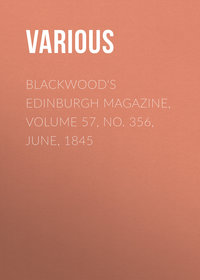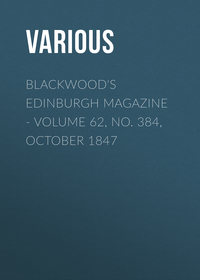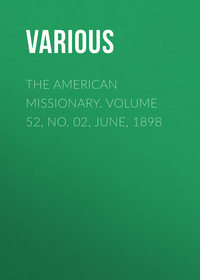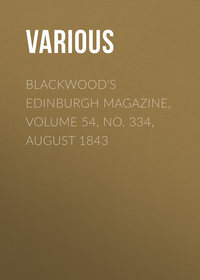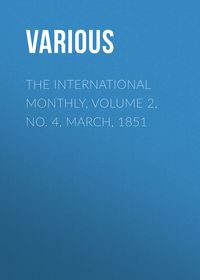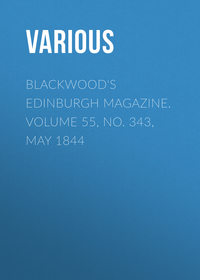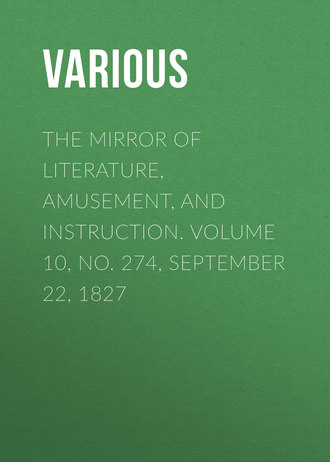 полная версия
полная версияThe Mirror of Literature, Amusement, and Instruction. Volume 10, No. 274, September 22, 1827

Various
The Mirror of Literature, Amusement, and Instruction / Volume 10, No. 274, September 22, 1827
No. II
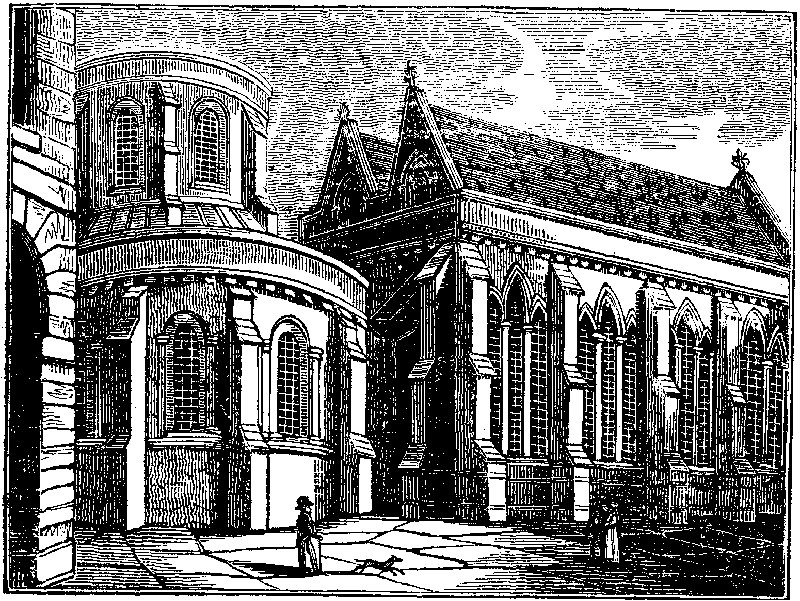
THE TEMPLE CHURCH.
The Temple Church,1 London, was erected in the twelfth century; but among antiquarians considerable difference of opinion at various times prevailed as to who were the original builders of these round churches, which form the most striking and beautiful specimens of the architectural skill of our Anglo-Norman ancestors. In England there are four examples of round churches, almost in perfect preservation, namely, the church of St. Mary, Temple; St. Sepulchre, Northampton; St. Mary, Cambridge; and that of Little Maplestead, Essex. It was long thought that they were of Jewish origin; but through the ingenious and learned essays of Mr. Essex and of Mr. Britton, this erroneous notion has been entirely removed. Mr. Essex, in his Essay, observes, in support of his opinion, that "their Temple at Jerusalem was not of a circular form, neither was the Tabernacle of Moses; nor do we find the modern Jews affect that figure in building their synagogues. It has, however, been generally supposed that the round church at Cambridge, that at Northampton, and some others, were built for synagogues by the Jews while they were permitted to dwell in those places. But as no probable reason can be assigned for this supposition, and I think it is very certain that the Jews who were settled in Cambridge had their synagogue, and probably dwelled together in a part of the town now called the Jewry, so we may reasonably conclude the round churches we find in other parts of this kingdom were not built by the Jews for synagogues, whatever the places may be called in which they stand."—It has been generally allowed by these and other writers on archaeology, that the primitive church of this form was that of the Holy Sepulchre at Jerusalem, and that the Temple Church at London was built by the Knights' Templars, whose occupation was the protection of Christian pilgrims against the Saracens. It has been further urged by a correspondent (Charles Clarke, Esq. F.S.A.) in the first volume of Britton's "Architectural Antiquities," that two of the before-mentioned round churches, namely, Northampton and Cambridge, were in fact built by "affluent crusaders, in imitation of that of the Holy Sepulchre;" and in support of his opinion he cites several historical notices.
The late perfect restoration of the Temple Church ought to be proudly recorded in our architectural annals. The excellence of the workmanship, and the native purity of the detail, evince not only scientific skill, but also a laudable motive of preserving this antique specimen of pure Anglo-Norman architecture from the ravages of time. Let the architect's attention be directed to the western doorway, and also to the interior of the church; and here, in good preservation, he will see excellent specimens of their mode of ornamenting the moldings by the cable, the lozenge, the cheveron, the nail-head, the billet, &c. &c., ornaments peculiar to the round style. The circular-headed windows, with their slender columns, also show, that in the restoration the style has not been tampered with; but substantial authorities have been quoted to perfect this praiseworthy attempt of the architect. That part of the church which has been added at a later date than the circular part, and for the convenience of divine worship, is lighted by the beautiful proportioned triple lancet-shaped windows, so justly admired. A writer in the Gentleman's Magazine for May, 1827, after making some judicious remarks, seems to think the crosses on the ends of the building, "as not in character with the building." Now as to architectural propriety in the decorations of a Christian church, no ornament could be better devised; and if we proceed to the antiquity of such ornament, I would observe, that the adoption would be equally correct, that being the insignia of the banner under which the Knights' Templars originally fought.
C. DAVY.BRIDGET TROT AND TIMOTHY GREEN.
(For the Mirror.)
"'Tis a common tale,An ordinary sorrow of man's life;A tale of silent sufferings, hardly clothedIn bodily form."WORDSWORTH.Miss Bridget Trot, a "wo"-man was,Of excellent repute,Who kept a stand in Leadenhall,And there disposed of fruit.And though in features rather dark,No fairer could be found;For what she sold, like ringing gold,When peeled, was always sound!She had moreover notions high,And thought herself aboveThe very low-ly common wayOf falling into love.And therefore when to her his suitA Snip did often pressWith vows of love, she cut him shortAt length, without re-dress.Yet nothing odd was there in thisOne case, it must be said;For who that wish'd a perfect manCould with a ninth part wed?Not she for one, whatever heMight do to make him smart,And howsoe'er her saying "Nay"Might add it to his heart.'Tis very strange, (yet so it is,)That vows should go for naught.But she who strove to 'scape love's toilsQuite unawares was caught!For though so hard to Snip at first,At last it chanced that sheA sort of soft emotion feltTowards one Timothy,A butcher—Green by name, but redIn face, as was his cap,And though he seldom tasted wine,A port-ly sort of chap.This man one day in passing by,In taste for what she'd got,Saw Biddy's stall—and 'twas her fateTo sell to him a lot!She thought his manners very sweet,He gave so fond a gaze;(But dashing blades of such like tradesHave ever killing ways!)And whilst he paid the coppers down,He had the brass to sayHer fruit was sweet, but sweeter stillThe apple of her eye.Besides all this, he looked so neatWhilst shouldering his tray;So what with steel, et cetera,Her heart was stole away!Lo! shortly after both agreed,They fixed the wedding day,But long before that day arriv'dHe took to stop away!From that same time her peace of mindAnd comfort were at steak—She did so lean to Mr. Green,Her heart was like to break!At last she went one morn to seeWhat he could be about,And hoped, alone, to find him in,But he had just popt out.She ax'd, "Is Mr. Green at home?"Of one who, with a laugh,Replied, "He's not! but if you pleaseI'll fetch his better half.""His what?" scarce uttered Bridget out,With uttermost dismay;And there she stopt, she could no more,And nearly swoon'd away!But when at length she was herself,And saw her faithless clown.She straightway went to blow him up,But got a good set down!"Oh, cold and faithless Tim," quoth she,"You vowed you couldn't smotherYour burning love for me, but nowYou're married to another!""Is this the way you treat me, sir?Too cheaply was I bought!I loved you dearly, but it seemsThat that all went for naught."She sighed, and gave one parting look,Then tore herself awayFrom her false swain and Mrs. Green,For ever and a day!And very soon got very ill,And very quick did die,And very truly verifiedHer love for Timothy!W.R.H.GREAT BELL OF GLASGOW.
(For the Mirror.)
In the steeple of Glasgow is a great bell, which is twelve feet one inch in circumference, and has a grave and deep tone. In 1789, it was accidentally cracked by some persons who got admission to the steeple. It was, therefore, sent to London, and cast anew. On the outside of it is the following inscription:—
In the year of grace1594,Marcus Knox,a merchant of Glasgow,zealous for the interests of the reformed religion,caused me to be fabricated in Hollandfor the use of his fellow citizens in Glasgow,and placed me with solemnityin the tower of their cathedralMy functionwas to announce, by the impress on my bosom,(Me audito venias doctrinam sanctam ut discas;2)andI was taught to proclaim the hours of unheeded time195 years had I sounded these awful warnings,when I was brokenby the hands of inconsiderate andunskilful menIn the year 1790,I was cast into the furnace,refounded at London,and returned to my sacred vocationReader,thou also shall know a resurrection,may it be to eternal lifeMALVINA.FANCY.
(For the Mirror.)
Me, oft hath Fancy, in her fitful dream,Seated within a far sequestered dell,What time upon the noiseless waters fell,Mingled with length'ning leafy shade, a gleamOf the departing sun's environ'd beam;While all was hush'd, save that the lone death-bellWould seem to beat, and pensive smite mine earLike spirit's wail, now distant far, now near:Then the night-breeze would seem to chill my cheek,And viewless beings flitting round, to speak!And then, a throng of mournful thoughts would pressOn this, my wild-ideal loneliness.Me, oft hath Fancy too, in musing hourSeated (what time the blithesome summer-dayWas burning 'neath the fierce meridian ray)Within that self-same lonely woodland bow'rSo sultry and still; but then, the tower,The hamlet tow'r, sent forth a roundelay;I seem'd to hear, till feelings o'er me stoleFaintly and sweet, enwrapping all my soul,Joy, grief, were strangely blended in the sound.The light, warm sigh of summer, was around,But ne'er may speech, such thoughts, such visions tell,Then, perfect most, when indescribable!M.L.B.FINE ARTS
THE PROGRESS OF PAINTING IN FRANCE.
(For the Mirror.)
Whether the French were first indebted to the Roman school for their knowledge of the art of painting is a matter of some doubt; indeed, several celebrated French writers affirm, that they first had recourse to the Florentine and Lombard schools; while others very strenuously declare, on the other hand, that the Venetian artists were alone resorted to, on account of the remarkable splendour of their colouring. A late author, however, observes, that the French do not appear to have imitated any school whatever, but to have adopted a style peculiar to themselves, which though perhaps not a noble one, is nevertheless pleasing. Though it is acknowledged that the French have a particular style, (i.e. a style of their own,) yet their progress in the arts has been exceedingly fluctuating and uncertain, so that it is actually impossible to ascertain who was the first reputable artist amongst them. Cousin was a painter on glass, and certainly obtained a good reputation amongst his countrymen. But he in fact possessed very little merit, and his name would not doubtless have been known to posterity had he not lived in a barbarous age, when the people knew not how to discriminate his errors and defects. He was supposed to be the best artist of his day, and consequently gained a reputation as such, though his works are far beneath mediocrity.
Francis I. was a great encourager of the fine arts, and the artists themselves were liberally paid for their productions, until that king was unfortunately taken prisoner at the battle of Pavia, in the year 1525. After the death of Francis, the kingdom was distracted with civil wars, so that painting was entirely neglected by his immediate successors. In the year 1610, however, Louis XIII. recovered the arts from their languid state. In his reign, Jaques Blanchard was the most flourishing painter; although Francis Perier, Simon Voüet, C.A. Du Fresnoy, and Peter Mignard, were equally gifted.
Of Charles Alphonse Du Fresnoy, author of a Latin poem, entitled De Arte Graphica, I shall attempt a little account. This painter was born at Paris in the year 1611. His father, intending him for the profession of physic, sent him to the university of Paris, where he made great progress in his studies, and obtained several prizes in poetry. He had a great inclination for painting as well as for poetry, and, though much against his father's desire, resolved to leave off the study of physic, and commence that of drawing. The force of his inclination subduing every measure adopted to suppress it, he took every opportunity of cultivating his favourite study. Leaving college, he placed himself under Francis Perier, from whom he learned the art of designing. He afterwards thought fit to travel into Italy, where he arrived in 1633. Being abandoned by his parents, who were highly incensed at his having rejected the study of physic, he was reduced to the utmost distress on his arrival at Rome, and was compelled to paint trifling pieces for his daily subsistence. After two years of extreme toil and difficulty, he was relieved by the arrival of Mignard, the artist, who had formerly been the companion of his studies. Mignard evinced the warmest regard for his friend, and they were afterwards known in Rome by the name of the inseparables, for they lived in the same house, worked together, and united the produce of their labours. They were employed to copy all the best pictures in the Farnese Palace, and every evening attended an academy of drawing. Mignard was superior in practice, while Fresnoy was perfect master of the rules, history, and theory of his profession. They communicated their sentiments to each other, Fresnoy furnishing his friend with noble ideas, and the latter instructing the former to paint with more ease and dispatch. Fresnoy painted several fine pictures in Rome, and, in 1653, he left that city, in company with his friend, travelled to Venice, and then to Lombardy. Here the two friends parted,3 Mignard returning to Rome, and Fresnoy to his native city. After his arrival in Paris, he painted some beautiful historical pictures, which established his reputation. He perfectly understood architecture, and drew designs for many elegant mansions in Paris. During his travels in Italy, he planned and composed his De Arte Graphica, an excellent poem, full of valuable information, and containing unerring rules for the painter. This poem was twenty years in hand, and was not published until three years4 after the author's death, which took place in 1665. It has been observed, that Fresnoy possessed the genius requisite for forming a great master; and had he applied himself more strictly to painting, and educated pupils, he would doubtless have proved one of the greatest painters France ever produced. But, possessing high literary talents, he chose to lay down precepts for his countrymen, rather than to present them with examples of his art. He adhered too closely to the theory of painting, neglecting the more essential part—practice.
In the reign of Louis XIV., Nicholas Poussin distinguished himself as a painter, by displaying exquisite knowledge and great skill in composition. He generally painted ancient ruins, landscapes, and historical figures. He was likewise well acquainted with the manners and customs of the ancients; and, though he educated no pupils, and never had any imitators, his pictures are universally admired in every European country. Charles le Brun5 established the French school,—an undertaking which Voüet had previously attempted. Le Brun drew well, had a ready conception, and a fertile imagination. His compositions are vast, but, in various instances, they may justly be termed outre. He possessed the animation, but not the inspiration of Raphael; and his design is not so pure as that of Domenichino, nor so lively as that of Annibale Caracci. Eustache le Seur, Le Brun's rival, possessed remarkable dignity, and wonderful correctness of style. Indeed, by some he has been called the Raphael of France. Had he lived longer, (for he died at the age of thirty-eight,) the French school, under his direction, would most probably have adopted a manner which might have been imitated, and which might have established the arts on an eminence to vie with even imperial Rome. But, by the concurrence of extraordinary circumstances, Le Brun was the fashionable painter of the time, and it therefore became necessary to imitate his manner, rather than the more simple and more refined one of his rival. As Le Brun's imitators wanted his genius, his faults not only became current, but more glaring and deformed.
After Le Brun's death, which took place in 1690, the French artists degenerated greatly, their productions being decorated in a gaudy and theatrical way, without due regard to taste or decorum. Their school, some years ago, altered its principles, under the auspices of the spirited Count de Caylus, who possessed considerable merit as an artist. The count, by his high rank and fortune, had the means of encouraging the imitators of the ancients, and of procuring the best models in Italy for study. He, in conjunction with Monsieur Vien, first formed the design of restoring a pure taste in France; and if his countrymen had followed the path thus marked out for them, they would now have been equal to the greatest of the Greek painters. But it appears that they are incapable of rising to any very extraordinary height in the arts, for, with the exception of Le Seur, and one or two others, they have ever wanted that elevation of mind which so eminently distinguished the Romans. Though De Caylus greatly purified painting in his time, yet his precepts and examples had little or no weight after his death, for the art again retrograded into its original state—a state from which the French professors, as before observed, seem incapable of rising.
In our own days some few French artists have distinguished themselves, particularly Lefevre, who was the chief painter to Napoleon. A full-length portrait of the emperor in his coronation robes, for which Lefevre received the sum of five thousand Napoleons, and which I have lately had the pleasure of seeing, is very correct in drawing, and extremely rich and harmonious in colour; but it wants freedom and boldness of execution.
To conclude—the French are acknowledged to do pretty well within the precincts of their own country, though few of their pictures will stand in competition with those of the Italians, or with those produced in our own school.
G.W.N.MANNERS & CUSTOMS OF ALL NATIONS. No. XIII
SINGULAR JEWISH CUSTOM
Burckhardt, in his "Travels through Syria," &c. informs us, that at Tiberias, one of the four holy cities of the Talmud, the Jews observe a singular custom in praying. While the rabbin recites the Psalms of David, or the prayers extracted from them, the congregation frequently imitate, by their voice or gestures, the meaning of some remarkable passages; for example, when the rabbin pronounces the words, "Praise the Lord with the sound of the trumpet," they imitate the sound of the trumpet through their closed fists. When "a horrible tempest" occurs, they puff and blow to represent a storm; or should he mention "the cries of the righteous in distress," they all set up a loud screaming; and it not unfrequently happens, that while some are still blowing the storm, others have already begun the cries of the righteous, thus forming a concert which it is difficult for any but a zealous Hebrew to hear with gravity.
CHARACTER OF THE KARPIANS, (ARABS.)
They are such consummate thieves and rogues, that, according to an ancient tradition still current among them, they once tricked the devil himself. The story is as follows:—The devil had acquired a right to their fields, on which they agreed with him, that when their crops were ripe, they should retain the upper part and the devil should have the lower. They sowed all their lands with wheat, and the devil of course had nothing but the straw for his share. Next year the old gentleman, fully determined not to be again so bamboozled, stipulated that the upper part should belong to him and the lower to the Karpians; but then they sowed all their grounds with beet, turnips, and other esculent roots, and so the devil got nothing but the green tops for his portion.
Memoirs of Artemi.
THE MODERN WELSH
The people of the principality are clean and industrious; there is, however, in the nature of a Welshman such a hurriness of manner and want of method, that he does nothing well; for his mind is over anxious, diverted from one labour to another, and hence every thing is incomplete, and leaves the appearance of confusion and negligence. The common exercises of the Welsh are running, leaping, swimming, wrestling, throwing the bar, dancing, hunting, fishing, and playing at fives against the church or tower; and they constitute the joy of youth, and the admiration of old age. The convivial amusements are singing and versification. In these favourite exercises the performers are of humble merit; the singing is mere roar and squeak; and the poetical effusions are nonsense, vested in the rags of language; and always slanderous, because the mind of the bard is not fertile in the production of topics. The Welsh character is the echo of natural feeling, and acts from instantaneous motives. The fine arts are strangers to the principality; and the Welshman seldom professes the buskin, or the use of the mallet, the graver, or the chisel; but although deficient in taste, he excels in duties and in intellect.
Jones's History of Wales.
ITALIAN WOMEN
Italy and England are undoubtedly possessed of a greater share of female beauty than any other country in Europe. But the English and Italian beauties, although both interesting, are very different from one another. The former are unrivalled for the delicacy and bloom of their complexions, the smoothness and mild expression of their features, their modest carriage, and the cleanliness of their persons and dress; these are qualities which strike every foreigner at his landing. On my first arrival in England, I was asked by a friend how I liked the English women; to which I replied that I thought them all handsome. This is the first impression they produce. There is an air of calmness and pensiveness about them, which surprises and interests particularly a native of the south. They seem to look, if I may apply to them the fine lines of one of their living poets—
"With eyes so pure, that from the rayDark vice would turn abash'd away;Yet fill'd with all youth's sweet desires,Mingling the meek and vestal firesOf other worlds, with all the blissThe fond weak tenderness of this."The Italian beauties are of a different kind. Their features are more regular, more animated; their complexions bear the marks of a warmer sun, and their eyes seem to participate of its fires; their carriage is graceful and noble; they have generally good figures; they are not indeed angelic forms, but they are earthly Venuses. It has been supposed by some, that the habitual view of those models of ideal beauty, the Greek statues, with which Italy abounds, may be an indirect cause conducing to the general beauty of the sex; be that as it may, I think the fine features and beautiful forms of the Italian fair have a great influence upon the minds of young artists, and this is perhaps one of the principal reasons why Italy has so long excelled in figure painters. A handsome female countenance, animated by the expression of the soul, is among the finest works of nature; the sight of it elevates the mind, and kindles the sparks of genius. Raphael took the models of his charming Madonnas from nature. Titian, Guido, Caracci, and others, derived their ideas of female beauty from the exquisite countenances so frequent in their native country.
Italy in the Nineteenth Century.
MY COMMON-PLACE BOOK. No. XXII
A LINNET AT SEA
It has been often observed, that birds, in the course of their flight from one country to another, will frequently resort to the rigging of a ship, as a resting-place in their transit across the wide ocean. Mr. Gray, in his "Letters on Canada," gives the following instance:—Among the extraordinary things, he observes, one meets with at sea, it is not one of the least surprising to observe small land birds several hundred miles from land. I was sitting on deck, when, to my great surprise, my attention was arrested by the warbling of a bird. I looked up, and saw a linnet perched on the rigging, and whistling with as much ardour as if on a bush in a green meadow. It is not a little astonishing how these little birds should be able to continue on the wing so long as is necessary to fly several hundreds of miles, particularly when the usual shortness of their flight is considered. They continue sometimes with a vessel several days, and are frequently caught by the sailors; but it is remarked that they seldom live, though every care is taken to give them proper food. When the vessel rolls much, they find it difficult to retain their footing on the rigging, and you see them forced, as it were, to resume their flight in search of a better resting-place.


